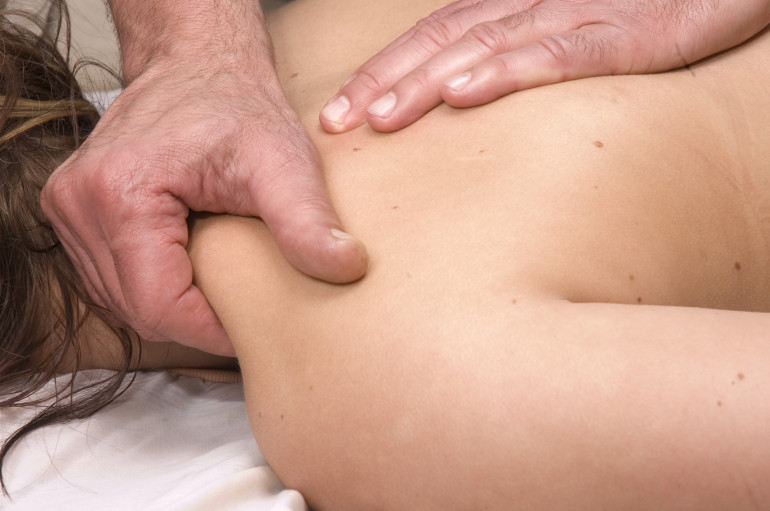Search Massage Therapists in Your Area
Deep tissue massage is a form of massage therapy that is used to realign the deeper layers of the muscles and connective tissues—addressing and resolving the underlying problems that can lead to chronic pain and stiffness. It differs from regular massage treatments; in that it addresses deeper, more rooted issues in the muscles and ligaments, and allows treatments to be more vigorous, successful and long-lasting.
Many people try a variety of massage treatments before moving toward deep tissue massage. Because treatment may be viewed as a “last resort”, it is often covered by insurance benefits.
Benefits of a Deep Tissue Massage
When a person experiences ongoing stiffness, tension, or sustained injury to their muscles, tendons and ligaments, these form a band of rigid inflexible tissues called adhesions (known colloquially as “knots”). While most adhesions are relatively minor, extreme cases can block circulation, limit movement and flexibility, and be extremely painful. Often, the only way to address these adhesions is through deep tissue massage treatments.
Adhesions, tension and stiffness can be related to a range of chronic conditions, and patients have found this type of massage effective in addressing:
Muscle tension
- Chronic pain, spasm or stiffness
- TMJ
- Inflexibility
- Limited Mobility
- Constricted blood flow
- Sciatica
- Muscle, tendon and ligament injuries
- High levels of stress
- Other conditions such as Fibromyalgia
Each of these conditions is improved by releasing adhesions and tension, increasing blood flow, and promoting further movement in the area. While deep tissue massage is helpful for a variety of conditions, it should be avoided in cases where the patient:
- Has inflamed skin or a rash
- Has bruising of any kind
- Has suffered a recent fracture or hernia
- May be pregnant
Make sure you check with your doctor before opting for this kind of treatment, and examine the reviews and qualifications of your therapist —never let anyone who is not qualified give you a deep tissue massage.

Medical Massage on Shoulder | MassageBook
How to Prepare for Deep Tissue Treatment

Medical Massage on Shoulder | MassageBook
If it is your first time receiving a deep tissue treatment, there are a few things you may want to do before your appointment. First, ensure that you’re well hydrated and have eaten a meal (nothing too heavy). Consider stretching before to ensure you get the most out of your treatment — this promotes blood flow and flexibility. If it is your first time visiting a massage therapist, relate all the issues you may be facing—after all, stiffness and chronic pain may be related to other injuries, poor posture, etc. The more your massage therapist knows, the more he/she can assist you during the session.
Try to arrive a few minutes early for your first appointment. This will give you time to fill out forms and ask questions.
The Experience
When receiving a deep tissue massage, you’ll be asked to lie down and breathe deeply, relax and prepare for the massage. Deep tissue treatments differ in that the movements tend to be longer, deeper, more intense and focused. Massage therapists may use their elbows, forearms, fingertips and muscles to access the deeper layers of your muscle tissues.
Since your therapist will be massaging the innermost layers of your connective tissues and muscles, there are parts of the treatment that may be uncomfortable or almost painful. It is important that you communicate this to your therapist at all times, however some level of discomfort is normal as the deeper knots, adhesions and injuries are being addressed.
Treatments generally last about an hour, and the massage will tend to focus more on problem areas. As a result, make sure you are engaged and communicative with your massage therapist throughout your session to ensure you get the full benefit of the visit.
What to Expect After a Deep Tissue Massage
After receiving a deep tissue massage, there may be some soreness or stiffness to your muscles that generally doesn’t last more than a day. Ensure that you drink plenty of water and to avoid strenuous exercise the day after your massage in order to help your muscles heal. Your massage therapist may recommend that you ice certain areas of your body, or that you take a hot bath—depending on what you’re being treated for.
Depending on the severity of the issue you’re trying to address, you may find that you feel a whole lot better after your first visit—with increased flexibility and blood flow. Still, if you are attempting to resolve a chronic condition, injury, or a condition such as extreme muscular adhesions, you may have to have a few treatments before you begin to feel well. Make sure you discuss how you feel and follow your therapist’s recommendations before and after every visit!